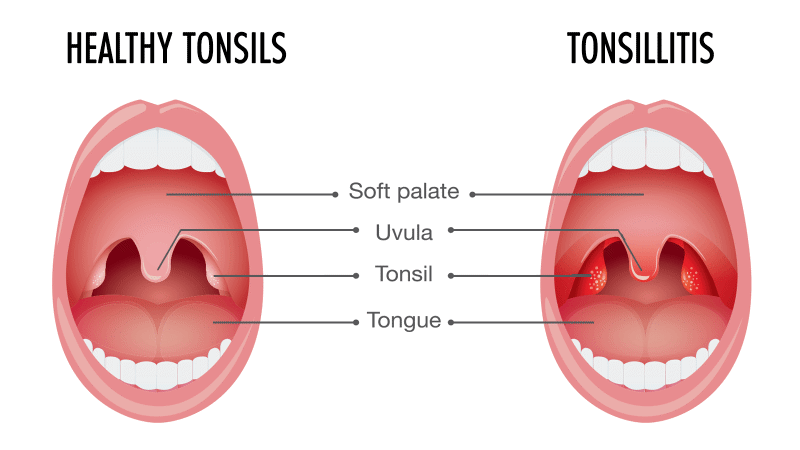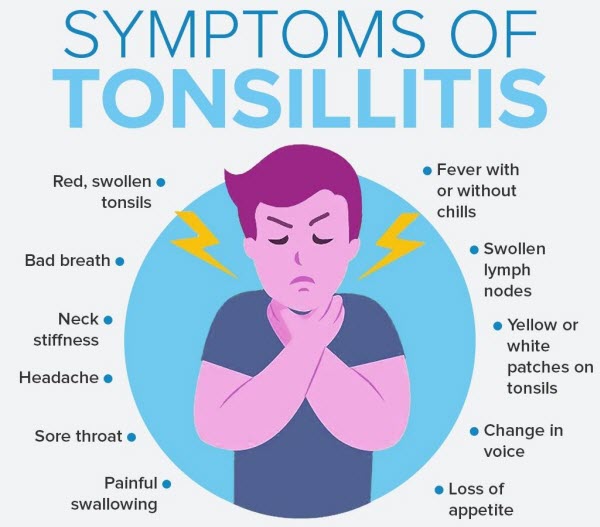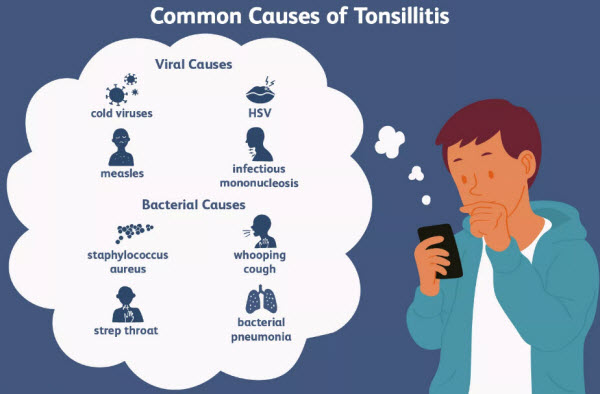This discussion includes the following information related to Tonsillitis:
- Tonsillitis
- Signs and Symptoms of Tonsillitis
- Causes of Tonsillitis
- Risk Factors for Tonsillitis
- Complications of Tonsillitis
- Tests and Diagnosis of Tonsillitis
- Treatment and Drugs for Tonsillitis
Tonsillitis Definition

Tonsillitis is inflammation of the tonsils, two oval-shaped pads of tissue at the back of the throat — one tonsil on each side. Signs and symptoms of tonsillitis include swollen tonsils, sore throat, difficulty swallowing and tender lymph nodes on the sides of the neck.
Most cases of tonsillitis are caused by infection with a common virus, but bacterial infections also may cause tonsillitis.
Because appropriate treatment for tonsillitis depends on the cause, it’s important to get a prompt and accurate diagnosis. Surgery to remove tonsils, once a common procedure to treat tonsillitis, is usually performed only when tonsillitis occurs frequently, doesn’t respond to other treatments or causes serious complications.
Signs and Symptoms of Tonsillitis

Tonsillitis most commonly affects children between preschool ages and the mid-teenage years. Common signs and symptoms of tonsillitis include:
- Red, swollen tonsils
- White or yellow coating or patches on the tonsils
- Sore throat
- Difficult or painful swallowing
- Fever
- Enlarged, tender glands (lymph nodes) in the neck
- A scratchy, muffled or throaty voice
- Bad breath
- Stomachache, particularly in younger children
- Stiff neck
- Headache
In young children who are unable to describe how they feel, signs of tonsillitis may include:
- Drooling due to difficult or painful swallowing
- Refusal to eat
- Unusual fussiness
EMERGENCY CASE Call your doctor if your child is experiencing: Get immediate care if your child has any of these symptoms:
Causes of Tonsillitis

The majority of cases of tonsillitis are caused by a virus, while anywhere from five percent to 40 percent are believed to be caused by bacteria.
Some of the more common viral causes include:
- Cold viruses (including rhinoviruses and adenoviruses)
Infectious mononucleosis - Cytomegalovirus (CMV)
- Epstein-Barr virus (EBV)
- Herpes simplex virus (HSV)
- Measles
The most common bacterial causes include:
- Staphylococcus aureus (including MRSA)
- Whooping cough (pertussis)
- Bacterial pneumonia
- Streptococcal pyogenes (strep throat)
Non-infectious causes of swollen tonsils are rarer but may include cancer of the tonsils and cryptic tonsils.
Why do tonsils get infected?
Your tonsils are a part of the lymphatic system, which is responsible for eliminating toxins and harmful microorganisms (including viruses and bacteria) from your body. Your tonsils work by trapping inhaled particles and delivering them to the lymphatic system to be neutralized.
There are three pairs of tonsils in your body:
- Pharyngeal tonsils, also known as adenoids, located at the roof of your mouth near where your nose connects to your throat
- Lingual tonsils, located behind the tongue
- Palatine tonsils, located at the back of the throat
Tonsillitis occurs when a virus or bacteria enters the mouth or nose and becomes trapped by the tonsils. When the happens, the immune system will target and attack the invaders and trigger an inflammatory response, causing fever and swelling.
Tonsillitis is common, with most people experiencing at least one episode before adulthood, and it is highly contagious. It is most often seen in children ages five to 15 but can also occur between the ages 15 and 25. The risk tends to decline as a person gets older.


